Beechcraft King Air
This article is about 90 and 100 Series King Airs. For 200 and 300 Series King Airs, see the Beechcraft Super King Air article.
| King Air | |
|---|---|
|
|
|
| King Air 100 | |
| Role | Civil utility aircraft |
| Manufacturer | Beechcraft |
| First flight | May 1963 |
| Introduced | 9 September 1964 |
| Status | Active service |
| Primary users | United States Navy Japan Maritime Self-Defense Force Royal Flying Doctor Service of Australia |
| Number built | 3,100+ |
| Unit cost | King Air C90GTi $3.4 million |
| Developed from | Beechcraft Queen Air |
| Variants | Beechcraft Super King Air |
The Beechcraft King Air family is part of a line of twin-turboprop aircraft produced by the Beech Aircraft Corporation (now Beechcraft Division of Hawker Beechcraft). The King Air line comprises a number of models that have been divided into two families; the Model 90 and 100 series are known as King Airs, while the Model 200 and 300 series were originally marketed as Super King Airs, with "Super" being dropped by Beechcraft in 1996 (although it is still often used to differentiate the 200 and 300 series King Airs from their smaller stablemates).
The King Air was the first aircraft in its class and has been in continuous production since 1964. It has outsold all of its turboprop competitors combined. The Model 90 series is the only small twin-turboprop business aircraft in production. It now faces competition from jet aircraft such as the Beechcraft Premier I and Cessna Citation Mustang as well as newer single-engine turboprop aircraft, namely the Piper Malibu and Socata TBM.
Contents |
Development
Model 90 series
The Model 90 King Air was conceived as the Model 120 in 1961. In May 1963, Beechcraft began test flights of the proof-of-concept Model 87, a modified Queen Air with Pratt & Whitney Canada PT6A-6 engines. On 14 July, Beech announced a new type, and a month later began accepting orders for the "King Air", with deliveries to commence in Autumn 1964.[1] After 10 months of test flying, in 1964 the Model 87 was delivered to the United States Army as the NU-8F. On 24 January, the first definitive prototype, by now designated Model 65-90 and also fitted with PT6A-6 engines, flew for the first time. The first production aircraft was delivered on 8 October, and by the end of the month, 152 aircraft had been ordered;[2] by year's end, seven had been built.[3]
In 1966, after 112 65-90s were completed,[3] production switched to the Model 65-A90 with PT6A-20 engines. As a measure of the type's popularity, 206 65-A90s were built in less than two years when production switched to the Model B90, the first of these rolling off the production line in 1968.[3] Military versions built during these years included the 65-A90-1, 65-A90-2, 65-A90-3, and 65-A90-4, all being unpressurised models based on the Model 87. These were produced for the US Army which designated them U-21s of various sub-models; many were fitted out for electronic battlefield surveillance. A total of 162 of these were built between 1967 and 1971.

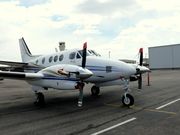
A total of 184 B90 models were produced before the Model C90 was introduced in 1971,[3] with wingspan increased over earlier models by 4 ft 11 in (1.50 m) to 50 ft 3 in (15.32 m), Maximum Take-Off Weight (MTOW) increased by 350 lb (160 kg) to 9,650 lb (4,378 kg), and PT6A-20A engines. The broadly similar Model E90 was introduced the following year, with PT6A-28 engines; the two were produced in parallel. Further refinement of the 90 series resulted in the Model F90 and follow-on Model F90-1. The F-models featured the T-tail of the Model 200 King Air mated to the fuselage and wings of the E90, with PT6A-135 engines of 750 shp (560 kW) driving four-bladed propellers. The F90 prototype flew on 16 January 1978 and 203 production versions followed between 1979 and 1983, when the F90 was superseded by the F90-1.[3] The F90 prototype was re-engined with Garrett AiResearch TPE-331 engines to test the feasibility of a Model G90, but this model was not put into production.
The Model C90-1 entered production in 1982 after 507 C90s and 347 E90s had been built,[3] and featured PT6A-21 engines and improvements to the pressurisation system. 54 were built.[3][4] The following year the F90-1 was put into production with redesigned engine cowlings, upgraded PT6A-135A engines, hydraulic landing gear, and triple-fed electrical bus; only 33 were built by the time production terminated in 1985.[3] The C90-1 was soon followed by the Model C90A, which featured the redesigned engine cowlings of the F90-1. The C90A received an increase in MTOW in 1987, being certified to 10,100 lb (4,580 kg). The C90A model was in production until 1992, by which time 235 had been built, all but 74 with the increased MTOW.
Only two C90As were built in 1992, the Model C90B followed that year with airframe improvements, four-bladed propellers, and propeller synchrophasing,[5] all in an effort to reduce cabin noise. This model also had PT6A-21s; the first production C90B was fitted with the 10,000th PT6 engine delivered to Beechcraft. In 1994 a cheaper version was introduced as the C90SE (Special Edition), with three-bladed propellers, standardised interior and mechanical instruments instead of the Electronic Flight Instrument System (EFIS) fitted to the C90B.[6] A total of 456 C90Bs and C90SEs were delivered by the time production of these models ended in late 2005.[3]
In July 2005, during the Oshkosh Airshow, Beechcraft introduced the C90GT. The C90GT was fitted with 750 shp (560 kW) PT6A-135As, flat rated to the same 550 shp (410 kW) as the earlier King Airs. This engine change increased performance due to lower operating temperatures, improving both cruise speed and climb rate. With a 275 kt (509 km/h, 316 mph) cruise speed, the C90GT was highly competitive with the new generation of Very Light Jets over short to medium distances, while providing a larger and more luxurious cabin. C90GT deliveries commenced at the beginning of 2006.[3] On 21 May 2007, during the 7th Annual European Business Aviation Convention & Exhibition in Geneva, Beechcraft announced the Model C90GTi updated version of the C90GT[7], featuring the Rockwell Collins Proline 21 avionics package previously only offered for the B200 and B300 King Airs. Deliveries commenced in 2008 after 97 C90GTs were delilvered to customers over the previous two years.[3]
Model 100 series
The Model 100 is a stretched derivative of the Model 90 featuring five cabin windows instead of the Model 90's three; MTOW increased by 1,300 lb (590 kg) over the 90, to 10,600 lb (4,810 kg). The 100 used the wings, tail, and engines (two PT6A-28 engines rated at 620 shp) from the Model 99 airline, itself a development of the Queen Air (as was the Model 90).
The Model 100 was flown for the first time on 17 March 1969 and unveiled to the public in May. 89 Model 100s were built before it was superseded by the Model A100 in 1972, with a further increase in MTOW to 11,500 lb (5,220 kg), fuel capacity increased by 94 US Gallons (357 litres), and four-bladed propellers. A total of 157 A100s were built by the time production of this model ceased in 1979. The next in the series was the B100, which featured 715 shp (533 kW) Garrett AiResearch TPE-331 engines as an alternative to the Pratt & Whitneys offered on other King Airs, and another increase in MTOW to 11,800 lb (5,350 kg). The B100 was introduced in 1976 and was produced concurrently with the A100 for several years; manufacture ceased in 1983 after 137 were built. The Model 200 Super King Air was developed from the Model 100, with the same fuselage design (with some differences, mainly associated with the different tails) being used for both models. The Model 200 had different wings and a T-tail and entered service in 1974.
Military King Air versions
The Japan Maritime Self-Defense Force (JMSDF) has operated a total of 40 C90 and C90A King Airs, with deliveries beginning in 1973. These have been given various designations by the JMSDF and consist of 34 TC-90 trainers, five LC-90 transports and a single UC-90 which is configured for photographic aerial survey. The TC-90s and the UC-90 comprise the 202 Kyoiku Kokutai (Training Squadron) based at Tokushima, while the LC-90s are attached to various Lockheed P-3 Kokutai (Squadrons) and a NAMC YS-11 Kokutai[8] as liaison aircraft. In late 2005 the JMSDF marked 500,000 accident-free flying hours of the TC-90 trainer fleet.[9]
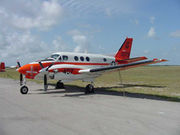
The U.S. military has used King Air 90s in various roles, primarily VIP and liaison transport, with designations including the VC-6A, the T-44 Pegasus, and the U-21 Ute. The U-21 Ute used by the US Army was the most common version.
Most U-21s were unpressurized Model 87 derivatives, but there were also five U-21Fs based on the A100 King Air; and three U-21Js, which Beechcraft designated Model A100-1, but were actually the first three production Model 200 Super King Airs (C/Ns BB-3, BB-4 and BB-5, after prototypes C/N BB-1 and BB-2 had been built). The majority of U-21s were delivered as U-21As (102 65-A90-1s), but there were also four RU-21As (65-A90-1s), three RU-21Bs (65-A90-2s), two RU-21Cs (65-A90-3s), 18 RU-21Ds (65-A90-1s), 16 RU-21Es (65-A90-4s), and 17 RU-21Gs (65-A90-1s). The RU-21Es (except one written off) were later converted to U-21Hs and RU-21Hs, with two U-21Hs and an RU-21H being further converted to JU-21Hs.[10] As of August 2008, only the three surviving RU-21As remain in military service.[11] The majority of the U-21 series were retired in the second half of the 1990s and most are now owned by Dynamic Aviation of Bridgewater, Virginia. Some have been modified as spraying aircraft and are used on insect control work.[12]
The T-44A Pegasus is a trainer version, designated the Model H90 by Beechcraft, used to train United States Navy, Marine Corps, Coast Guard, and Air Force pilots to fly multi-engine aircraft. A total of 61 were delivered to the US Navy between 1977 and 1980. In August 2006, the Navy announced that after 29 years of operation, the T-44A fleet would be upgraded with modernized avionics systems, and redesignated T-44Cs.[13]
Two VC-6A aircraft were operated by the US military. One was a Model 65-A90 operated by the US Army and serialled 66-15361,[14] the other a B90 operated by the United States Air Force as Air Force One.
Air Force One
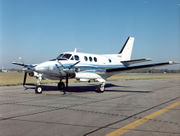
During the administration of President Lyndon Johnson, the United States Air Force acquired a Model B90 King Air "off-the-shelf". With the military designation VC-6A, the aircraft, serialled 66-7943,[15] was used to transport President Johnson between Bergstrom Air Force Base (near Austin, Texas) and the Johnson family ranch near Johnson City, Texas. When Johnson was aboard, the aircraft used the callsign Air Force One. This aircraft is now on display, with other presidential aircraft, at the National Museum of the United States Air Force at Wright Patterson Air Force Base near Dayton, Ohio.
Modification and upgrade programs
A number of aftermarket modifications and upgrades are available for 90 and 100 Series King Airs.[16] An engine upgrade involves earlier-build 90 Series aircraft being re-engined with the PT6A-135A engines of the C90GT.[17][18] A more radical re-engining program involves the replacement of the PT6s in C90 and E90 King Airs with TPE-331s.[19]
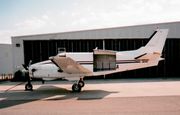
Among the numerous airframe modifications available; a cargo conversion for the 90 model, the CargoLiner, which replaces the rear door with a large pallet accessible cargo door, a heavy duty floor structure and cabin cargo liner, also a crew hatch for cockpit access for the crew in the 90, 100, and 200[20]; a Wing Front Spar Reinforcement Kit for both 90 and 100 Series aircraft,[16]; a modification for the entire King Air line that entails reworking and extending the nose[21] to house a baggage compartment as well as the avionics normally found in the noses of King Air aircraft. Modifications available for the King Air 100 include a belly cargo pod similar to those fitted to the Beech 99 and the Model 1300 version of the King Air 200 series.[22]
Operators
Military operators
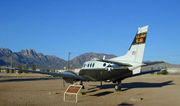
- Jamaica Defence Force
- Venezuelan Navy
Eight C90A King Airs were operated by Bombardier on behalf of the Canadian Air Force. These were used as multi-engine trainers and flew with Canadian civil registrations. All entered service in 1992[23] and were operated until 2005. That year a new contract was awarded to Allied Wings, a consortium of Kelowna Flightcraft Ltd., Canadian Helicopters Ltd, Canadian Base Operators and Atlantis Systems International, which uses seven civil-registered C90B King Airs[24][25].
Governmental operators
- Government of Province of Tierra del Fuego and Catamarca.
- Government of Canada - Transport Canada[26]
- Government of the Province of Alberta[26]
- Government of the Province of New Brunswick[26]
- Government of the Province of Saskatchewan[26]
- Chile's Civil Aviation Administration (DGAC).
- Drug Enforcement Administration
- Federal Aviation Administration
- Governments of the States of Arizona, Arkansas, Florida, Georgia, Indiana, Montana, New Mexico, North Dakota, Ohio and Tennessee[27]
- NASA
The Department of Civil Aviation of Papua New Guinea operated a C90 King Air for a number of years, but now operates a Model 200 Super King Air.
Civil operators
The King Air is used by many corporate and private users, it is also used as a light transport liaison aircraft with both government and non-government organisations. It is also used by air-taxi and air charter companies.
The Royal Flying Doctor Service of Australia previously operated a large number of 90 Series King Airs, but retired the last example in 2006, standardising on the King Air 200 Series and the Pilatus PC-12 for its fleet requirements.
Variants
A total of more than 3,100 King Air 90 and 100 series aircraft have been delivered as of August 2008:[28]
Beechcraft designations
- Model 87
- "Proof-of-concept" test aircraft; one built (c/no. LG-1).
- Model 65-90
- Prototypes and first production model; 112 built (c/nos. LJ-1 to LJ-113, except LJ-76).
- Model 65-A90
- 206 built (c/nos. LJ-76, LJ-114 to LJ-317; including c/nos. LJ-178 and LJ-178A), one (c/no. LJ-153) to US Army as VC-6A.
- Model 65-A90-1
- Based on the Model 87; 141 built and delivered to the US Army (c/nos. LM-1 to LM-141).
- Model 65-A90-2
- Based on the Model 87; three built and delivered to the US Army (c/nos. LS-1 to LS-3).
- Model 65-A90-3
- Based on the Model 87; two built and delivered to the US Army (c/nos. LT-1 and LT-2).
- Model 65-A90-4
- Based on the Model 87; 16 built and delivered to the US Army (c/nos. LU-1 to LU-16).
- Model B90
- Third civil model; 184 built (c/nos. LJ-318 to LJ-501), one (c/no. LJ-320) to USAF as VC-6A.
- Model C90
- Model C90A
- C90A - initial production run between 1984 and 1992 of 235 aircraft (c/nos. LJ-1063 to LJ-1299, except LJ-1288 and LJ-1295).
- C90B and C90SE - marketing names for updated versions of C90A produced between 1992 and 2005, 456 built[29] (c/nos. LJ-1288 and LJ-1295, LJ-1300 to LJ-1755, except LJ-1727 and LJ-1754).
- Model C90GT
- Version with flat-rated PT6A-135A engines; 97 built (c/nos. LJ-1727, LJ-1754, LJ-1756 to LJ-1768, LJ-1770 to LJ-1846, LJ-1848 to LJ-1852).[3]
- Model C90GTi
- Current production version (as of December 2008), variant of C90GT with Proline 21 avionics suite; at least 90 built[30] (c/nos. LJ-1769, LJ-1847, LJ-1853 & after).[3]
- Model C90GTx
- New production version with improved performance.
- Model E90
- Manufactured concurrently with the C90; 347 built (c/nos. LW-1 to LW-347).
- Model F90
- Prototype and production model with T-tail of the Super King Air; 203 built (c/nos. LA-1 to LA-204, except LA-202).
- Model F90-1
- Follow-on from F90; 33 built (c/nos. LA-202, LA-205 to LA-236).[3]
- Model G90
- F90 prototype re-engined with Garrett TPE-331s in place of the Pratt & Whitney PT6s originally fitted, c/no. LA-1/LE-0.
- Model H90
- Version manufactured for the US Navy; 61 built (c/nos. LL-1 to LL-61).
- Model 100
- Prototype and first production "long fuselage" King Air version; 90 built (c/nos. B-1 to B-89 and B-93).
- Model A100
- 157 built (c/nos B-90 to B-247, except B-93), prototype Model 100 c/no. B-1 also converted to A100 model in 1976, three years after introduction of A100 model. Five (c/nos. B-95 to B-99) to US Army as U-21Fs.
- Model B100
- Prototype (converted from A100 c/no. B-205) plus production model, all with Garrett TPE-331 engines instead of Pratt & Whitney PT6s fitted to previous models; 137 built (c/nos. B-205/BE-1, BE-2 to BE-137).
- Model A100-1
- Beechcraft designation for first three production Model 200 Super King Airs delivered to the US Army (c/nos. BB-3 to BB-5).
Military versions
- YU-21
- Modification of L-23 Seminole with PT6A-6 tuboprops. One converted.[31]
- U-21A Ute
- Utility aircraft for US Army, with fuselage of Queen Air 65-80 and wings of King Air 65-90, powered by 550 hp (410 kW) PT6A-20s. Beechcraft Model 65-A90-1. 102 built.[31][32]
-
- EU-21A
- Conversion of at least five U-21As as radio relay aircraft for use over Vietnam. Later re-converted to U-21A standard.[33]
- JU-21A
- Conversion of three U-21As with Left Jab Signals intelligence (SIGINT) system. Two later re-converted to U-21A standard.[33]
- RU-21A
- Conversion of four U-21As to carry Direction finding equipment as part of Cefirm Leader program, to work with RU-21B and RU-21C aircraft.[34]
- RU-21B
- Signals intercept aircraft as part of Cefirm Leader program. Powered by 620 hp (462 kW) PT6A-29s and with modified undercarriage. Beechcraft Model 65-A90-2. Three built.[35]
- RU-21C
- Similar to RU-21B, but carrying jamming equipment as part of Cefirm Leader. Beechcraft model 65-A90-3. Two built.[35]
- RU-21D
- ELINT aircraft similar to U-21A. It was unsuccessful and dd not reach service, with several having their electronic equipment removed to become U-21D utility aircraft. Beechcraft Model 65-A90-1. 18 built.[36]
- RU-21E
- ELINT version with Guardrail II, IIA or IV systems. Beechcraft Model 65-A90-5. 16 built.[37]
- U-21F
- Five King Air A100s used by US Army as transport/utility aircraft.[38]
- U-21G Ute
- U-21A with modified cockpit, mainly used as utility aircraft. Beechcraft Model 65-A90-1. 17 built.[38]
-
- RU-21G
- Three U-21Gs fitted with Guardrail I ELINT system.[38]
- RU-21H
- Conversion of 21 RU-21D, E and F aircraft to carry Guardrail V ELINT system. Higher gross weight.[39]
- U-21H Ute
- Modification of 23 RU-21E and G aircraft replaced in the ELINT role by later aircraft to utility aircraft.[39]
- JU-21H
- Two former RU-21Es converted as test aircraft.[39]
- VC-6A
- Two B90 King Airs, powered by 550 shp (410 kW) PT6A-20s. One used as transport by US Army, and one by USAF as VIP transport for President Lyndon B. Johnson.[40]
- T-44A Pegasus
- Multi-engine training aircraft for US Navy, based on King Air B90. Beechcraft Model H-90. 61 built.[40]
Other information
The ICAO designator, such as might be used in a PIREP or a flight plan, for the various King Airs are BE90 (various model 90s), and BE10 (model 100). With the exception of the F90 and F90-1, all 90 Series King Airs have been produced under the same Type Certificate (Number 3A20) used for Queen Air production.[41] All 100 Series King Airs were produced under the same Type Certificate (Number A14CE) used for Model 99 production.[42]
Specifications
King Air C90GTi
Specifications obtained from the FAA Type Certificate and the Hawker Beechcraft website[41][43]
General characteristics
- Crew: 1-2
- Capacity: 7 passengers maximum, depending on cabin configuration
- Length: 35 ft 6 in (10.82 m)
- Wingspan: 50 ft 3 in (15.32 m)
- Height: 14 ft 3 in (4.34 m)
- Wing area: 294 ft² (27 m²)
- Empty weight: 6,950 lb (3,150 kg)
- Max takeoff weight: 10,100 lb (4,580 kg)
- Powerplant: 2× Pratt & Whitney Canada PT6A-135A turboprops, driving Hartzell HC-E4N-3N propellers, 550 shp (410 kW) each
Performance
- Maximum speed: 311 mph True Air Speed (TAS) (270 knots TAS, 500 km/h TAS)
- Cruise speed: 260 mph Indicated Air Speed (IAS) (226 kts IAS, 416 km/h IAS)
- Stall speed: 90 mph (78 knots, 145 km/h) IAS (flaps down)
- Range: 1,530 miles (1,321 nm, 2,446 km)
- Service ceiling: 30,000ft (9,144 m)
- Rate of climb: 2,003 ft/min (10.2 m/s)
- Wing loading: 34.3 lb/ft² (170 kg/m²)
- Power/mass: 0.099 hp/lb (179 W/kg)
King Air B100
Specifications obtained from The International Directory of Civil Aircraft, 1997/98 Edition[44].
General characteristics
- Crew: 1-2
- Capacity: 13 passengers maximum, depending on cabin configuration
- Length: 39 ft 11 in (12.17 m)
- Wingspan: 45 ft 11 in (14.0 m)
- Height: 15 ft 5 in (4.7 m)
- Wing area: 279.7 ft² (26.0 m²)
- Empty weight: 7,092 lb (3,212 kg)
- Max takeoff weight: 11,800 lb (5,352 kg)
- Powerplant: 2× Garrett TPE-331-6-251B or -252 turboprops, driving 3-bladed propellers, 840 shp, flat-rated to 715 shp (533 kW) each
Performance
- Maximum speed: 307 mph Indicated Air Speed (IAS) (265 kts IAS, 491 km/h IAS)
- Range: 1,525 mi (1,325 nm, 2,455 km)
- Service ceiling: 24,850 ft (7,574 m)
- Rate of climb: 2,140 ft/min (10.87 m/s)
- Wing loading: 42.2 lb/ft² (205.84 kg/m²)
- Power/mass: 0.121 hp/lb (199.17 W/kg)
See also
Related development
- Beechcraft Queen Air
- Beechcraft Super King Air
- Beechcraft Model 99
Comparable aircraft
- Cessna 425
- Cessna 441
- Mitsubishi MU-2
- Piaggio P.180 Avanti (to Model 100 Series)
- Piper PA-31T Cheyenne
- Embraer EMB 121 Xingu
References
Notes
- ↑ Beech King Air timeline retrieved 2008-08-07.
- ↑ Green, William. "Beech 65-90 King Air", The Observer's Book of Aircraft, 1965 Edition. Frederick Warne & Co. Ltd., London. No ISBN, Library of Congress Catalog Card No. 57-4425.
- ↑ 3.00 3.01 3.02 3.03 3.04 3.05 3.06 3.07 3.08 3.09 3.10 3.11 3.12 3.13 3.14 Hawker Beechcraft aircraft Serial Number Lists 1945-2008 retrieved 2008-08-06.
- ↑ R.W.Simpson, Airlife's General Aviation, Airlife Publishing, England, 1991, ISBN 1 85310 104 X, pp 47
- ↑ A system fitted to many twin-engined propeller-driven aircraft, it matches propeller revolutions-per-minute and also "phases" the position of the blades of each propeller relative to the other, so the cabin noise is more even.
- ↑ 6.0 6.1 New Zealand Civil Aviation Authority Beechcraft C90A Type Acceptance Report retrieved 9 December 2008.
- ↑ Hawker Beechcraft Press Release retrieved 2007-09-20.
- ↑ Japan Maritime Defence Force Order of Battle accessed via this webpage, retrieved 2007-10-09.
- ↑ Hawker Beechcraft Press Release retrieved 2007-10-09
- ↑ USAF FY1970 Serial Number list retrieved 3 September 2007.
- ↑ Information derived from LAASdata online King Air 90 survivors database accessed 2008-08-07.
- ↑ Information derived from conducting an online search of the US civil aircraft register using "LM-" (the serial number prefix for A90-1 aircraft). Search conducted 2007-09-09.
- ↑ Vendrasco, Stephanie, "Transforming the Pegasus"
- ↑ USAF FY1966 Serial Number list retrieved 2007-09-03.
- ↑ A list of civil aircraft types used by the US military retrieved 2007-09-03.
- ↑ 16.0 16.1 A non-comprehensive list of STCs available for King Air series aircraft retrieved 2007-09-20.
- ↑ Silverhawk Conversions Home page retrieved 2008-02-07.
- ↑ Blackhawk Modifications Inc. Blackhawk XP page retrieved 2007-09-20.
- ↑ Kilo Alpha web page retrieved 2007-10-16.
- ↑ http://www.aerocrafters.net
- ↑ FAA STC No. SA00367SE retrieved 2007-09-20.
- ↑ Commuter Air Technology King Air 100 page retrieved 2007-09-20.
- ↑ List of civil-registered aircraft of the Canadian Armed Forces retrieved 2007-10-09.
- ↑ Pugliese, David."Taking Wing", retrieved 2007-10-31.
- ↑ Canadian civil aircraft register search using "Allied Wings" as the Owner Name search parameter. Search conducted 2007-10-31.
- ↑ 26.0 26.1 26.2 26.3 Canadian civil aircraft register search using "Province of" or "Government of Canada, Department of Transportation" as the Owner Name search parameter. Search conducted 2010-07-15.
- ↑ US civil aircraft register search using "State of" as the Owner Name search parameter. Search conducted 2007-10-31.
- ↑ Unless otherwise noted, all information here is obtained from Production Lists in the book Beechcraft - Pursuit of Perfection and the online Production Lists available at LAASdata.com
- ↑ Due to disagreement between available online sources, it is impossible to determine the number of each sub-type built.
- ↑ The last King Air C90GTi built as of December 2008 is shown in the available online sources (LAASdata King Air 90 list and various nations' online civil aircraft Registers) as c/no. LJ-1946, however there are gaps for registered King Airs, with some above c/no. LJ-1900 not listed.
- ↑ 31.0 31.1 Kaminsky International Air Power Review Winter 2003/2004, p.88.
- ↑ Kaminsky International Air Power Review Winter 2003/2004, p.74.
- ↑ 33.0 33.1 Kaminsky International Air Power Review Winter 2003/2004, p.89.
- ↑ Kaminsky International Air Power Review Winter 2003/2004, pp. 89–90.
- ↑ 35.0 35.1 Kaminsky International Air Power Review Winter 2003/2004, p.90.
- ↑ Kaminsky International Air Power Review Winter 2003/2004, pp. 90–91.
- ↑ Kaminsky International Air Power Review Winter 2003/2004, p.91.
- ↑ 38.0 38.1 38.2 Kaminsky International Air Power Review Winter 2003/2004, p.92.
- ↑ 39.0 39.1 39.2 Kaminsky International Air Power Review Winter 2003/2004, p.93.
- ↑ 40.0 40.1 Kaminsky International Air Power Review Spring 2004, p.90
- ↑ 41.0 41.1 Queen Air and King Air 90 series Type Certificate Data Sheet retrieved 2007-09-20.
- ↑ Model 99 and King Air 100 series Type Certificate Data Sheet retrieved 2008-01-21.
- ↑ Hawker Beechcraft C90GTi Specifications retrieved 2008-08-07.
- ↑ Frawley, Gerald. The International Directory of Civil Aircraft, 1997/98 Edition. Aerospace Publications Pty. Ltd. Canberra ACT, 1997. ISBN 1 875671 26 9
Bibliography
- Kaminski, Tom. "Variant File: US Military King Airs: Part 1 Beech/Raytheon U-21 and C-12". International Air Power Review. Volume 11, Winter 2003/2004. ISBN 1-880588-60-9. ISSN 1473-9917. pp. 74–93.
- Kaminski, Tom. "Variant File: US Military King Airs Part 2: C-12". International Air Power Review. Volume 12, Spring 2004. ISBN 1-880588-77-3. ISSN 1473-9917. pp. 90–98.
- Jackson, Paul (2003). "Beech King Air B200". Jane's All the World's Aircraft 2003-2004: pp. 531–532. ISBN 0-7106-2537-5.
- Phillips, Edward H. Beechcraft - Pursuit of Perfection, A History of Beechcraft Airplanes. Flying Books, Eagan, Minnesota 1992. ISBN 0-911139-11-7
- Taylor, M. J. H. ed. Jane's Encyclopedia of Aviation Studio Editions Ltd. ISBN 1 85170 324 1
External links
- Smithsonian National Air and Space Museum - Beechcraft King Air 65-90
- National Museum of the US Air Force - Beechcraft VC-6A
- Beechcraft King Air website
- Beech King Air timeline from Wings of Kansas
|
||||||||||||||
|
||||||||||||||||||||
|
||||||||
|
|||||
|
||||||||||||||